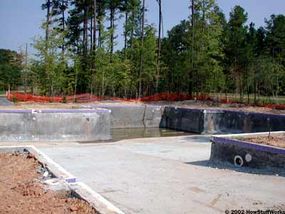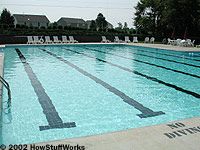Conceptually, swimming pools are pretty simple -- they're just big basins of water. But on a hot summer day, a swimming pool can seem like the greatest invention known to man. And as it turns out, there really is a lot of cool technology at work in your average pool -- much more than you might expect.
In this article, we'll find out how pools are built, and we'll take a look at the plumbing system that keeps the water clean and chemically balanced.
Advertisement
Pool Basics
Swimming pools come in all shapes and sizes, but nearly all of them, from the backyard personal pool to the water park wave pool, work in the same basic way. They use a combination of filtration and chemical treatment to continually clean a large volume of water.

A typical swimming pool needs seven major components:
- A basin
- A motorized pump
- A water filter
- A chemical feeder
- Drains
- Returns
- PVC plastic plumbing connecting all of these elements
The basic idea is to pump water in a continual cycle, from the pool through the filtering and chemical treatment systems and back to the pool again. In this way, the pumping system keeps the water in the pool relatively free of dirt, debris and bacteria. Some pools also include heaters in the mix, in order to keep the water at a certain temperature.
In the next section, we'll look at the different types of pools.
